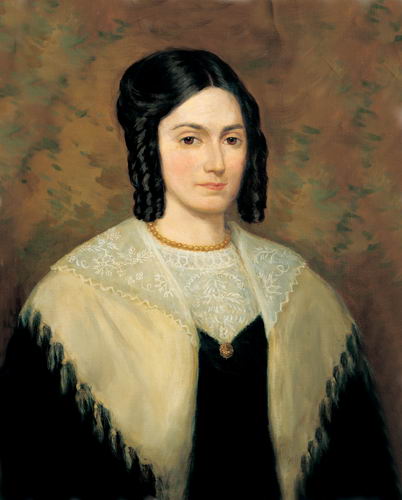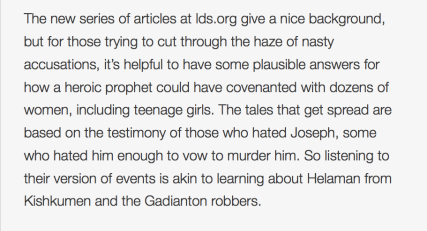 Yesterday, two new essays about polygamy became available on the LDS Church’s official website, joining a third that appeared late last year.
Yesterday, two new essays about polygamy became available on the LDS Church’s official website, joining a third that appeared late last year.
These statements contained some bombshells about Mormonism’s past that will not be news to most students of history but may indeed prove disturbing for some rank-and-file Latter-day Saints.
Five highlights of the revelations:
1) “Joseph Smith was sealed to a number of women who were already married.” Back in January after the first Gospel Topics statement about polygamy was released, one criticism I had was that there was no mention of the historical truth of polyandry in Nauvoo. It wasn’t widespread, but it did happen. Now the Church has openly acknowledged it.*
2) Some of those polyandrous relationships were for “eternity only,” but some may have been sexual. (“Other women [who were already married] left no records, making it unknown whether their sealings were for time and eternity or were for eternity alone.”)
3) Joseph Smith’s first plural marriage occurred as early as the mid-1830s, after an angel appeared to him three times to demand that he commence plural marriage. The third time, the angel brought a sword to drive home the point. Joseph wed Fanny Alger; whether his first wife Emma knew about it is unclear.
4) Many plural marriages were contracted without the first wife’s consent. “Emma likely did not know about all of Joseph’s sealings,” the statement tells us. Joseph received a revelation in 1843 that said that while a first wife was supposed be consulted, if she refused to accept the plural marriage then the husband was “exempt from the law of Sarah.” In other words, he could go on ahead with or without his wife’s blessing.
5) Most of Smith’s wives were between the ages of 20 and 40, but he also married teenagers. In what is perhaps the statement’s cagiest moment, plural wife Helen Mar Whitney is described as having been sealed to Joseph “several months before her 15th birthday,” rather than “at age 14.”
How have Mormons responded to the statements?
For the most part, the reaction has been very positive. “Those were rather open essays, acknowledging many of the uncomfortable details,” said a Deseret News commenter. The feeling was that it’s much better to get all this out in the open, to which I say AMEN.
A Reddit commenter was more specific: “Hot dang. We got Fanny Alger, Helen Mar Kimball, and Joseph marrying without Emma’s consent.”
But not everyone has been thrilled with the news. My Facebook feed has sported a range of reactions, from the been-there-done-that-got-the-t-shirt cynicism of “Oh, we’ve known about this stuff forever; it’s no big deal” to full-on stages of grief at the news that Joseph Smith really was married to teenage girls, and that he likely lied to Emma. Repeatedly.
And the first stage of grief is always denial, right? So there’s this:
That’s right. When in doubt, call those who disagree with you about history the Gadianton robbers.
Some of us reach the maturity of stage 5 a lot faster than others, it seems. So if you’re looking for wise, informed, well-modulated reactions to the news, check out Julie Smith’s cognitive-dissonance-free take on the polygamy statements at Times and Seasons. Smith focuses her attention on what the essays teach Mormons about how prophetic authority actually works:
“I think the odd confluence of 1950s American corporate culture, historical amnesia, and rapid world-wide growth led Mormonism to advance the idea that a CEO-like prophet got regular memos from God, bullet-pointed with precise operating instructions designed to maximize return for the next quarter. Diligent work by historians, now disseminated instantly and internationally, shows that that vision isn’t quite precise.”
Some TBMs may be uncomfortable with all of the provisional, hesitant language of the polygamy statements, especially the one on Kirtland and Nauvoo. That timid little word “may” sure got a workout there.
But “may” is actually where we’ve lived for a long time in understanding polygamy, even if we imagined we had the answers.







